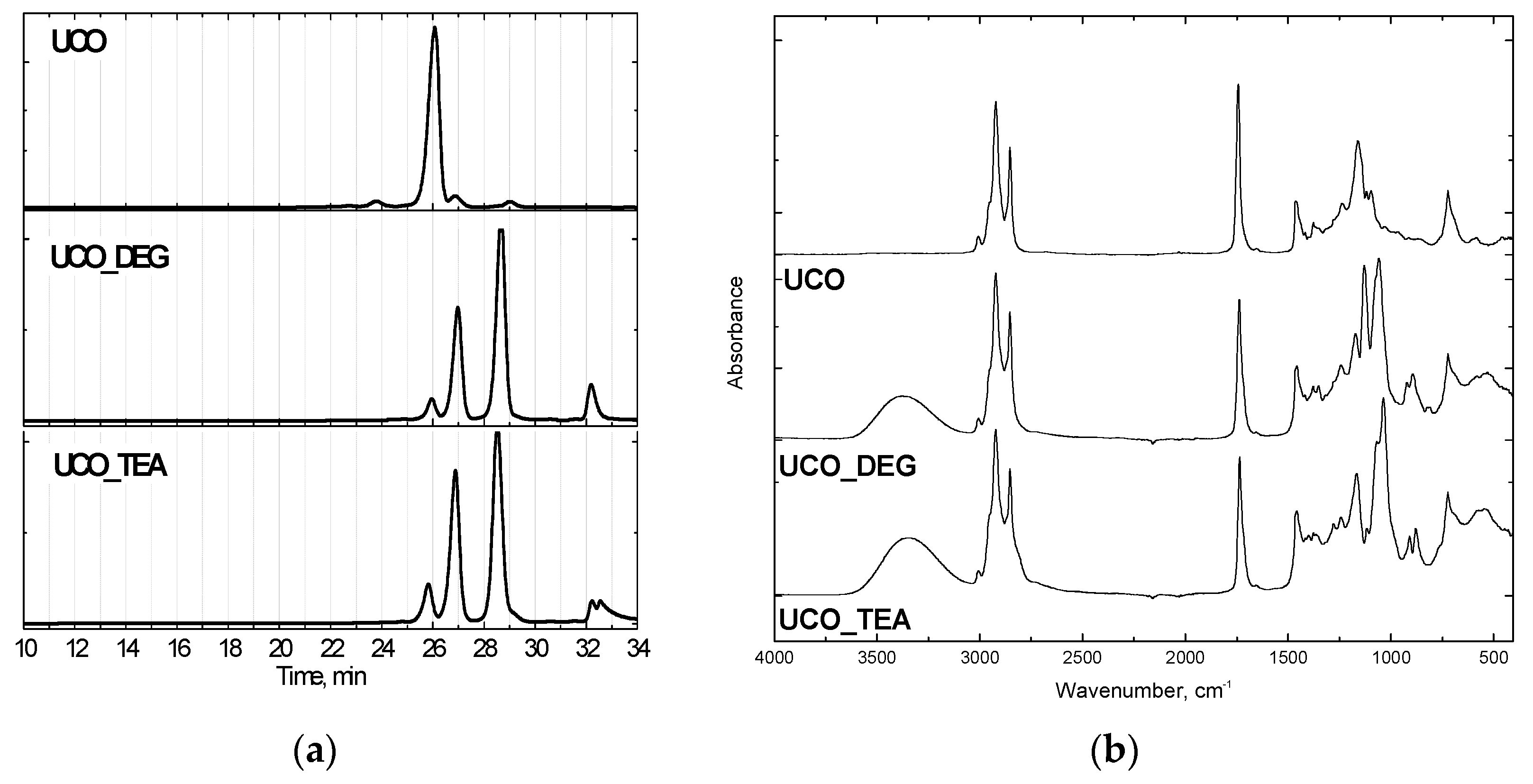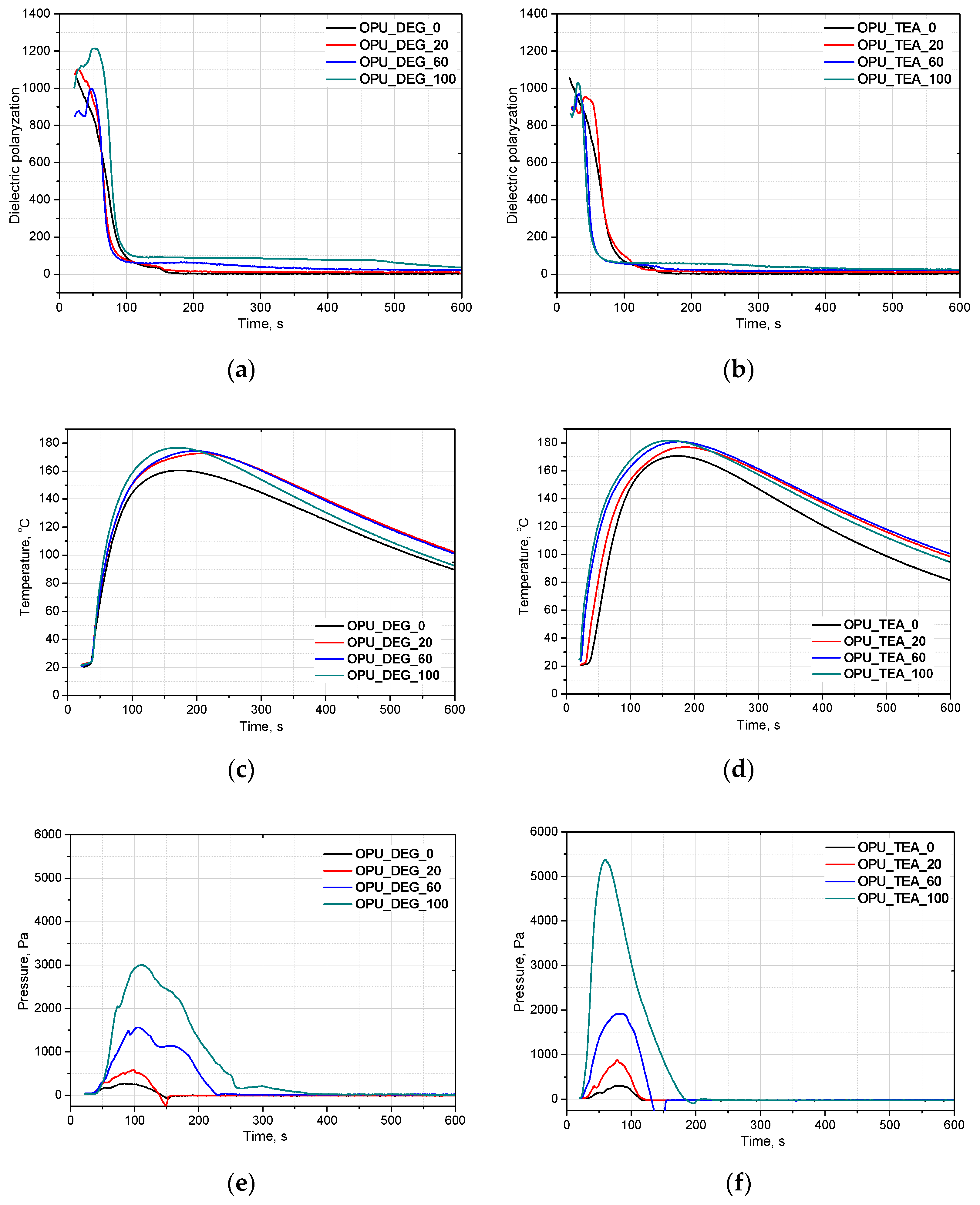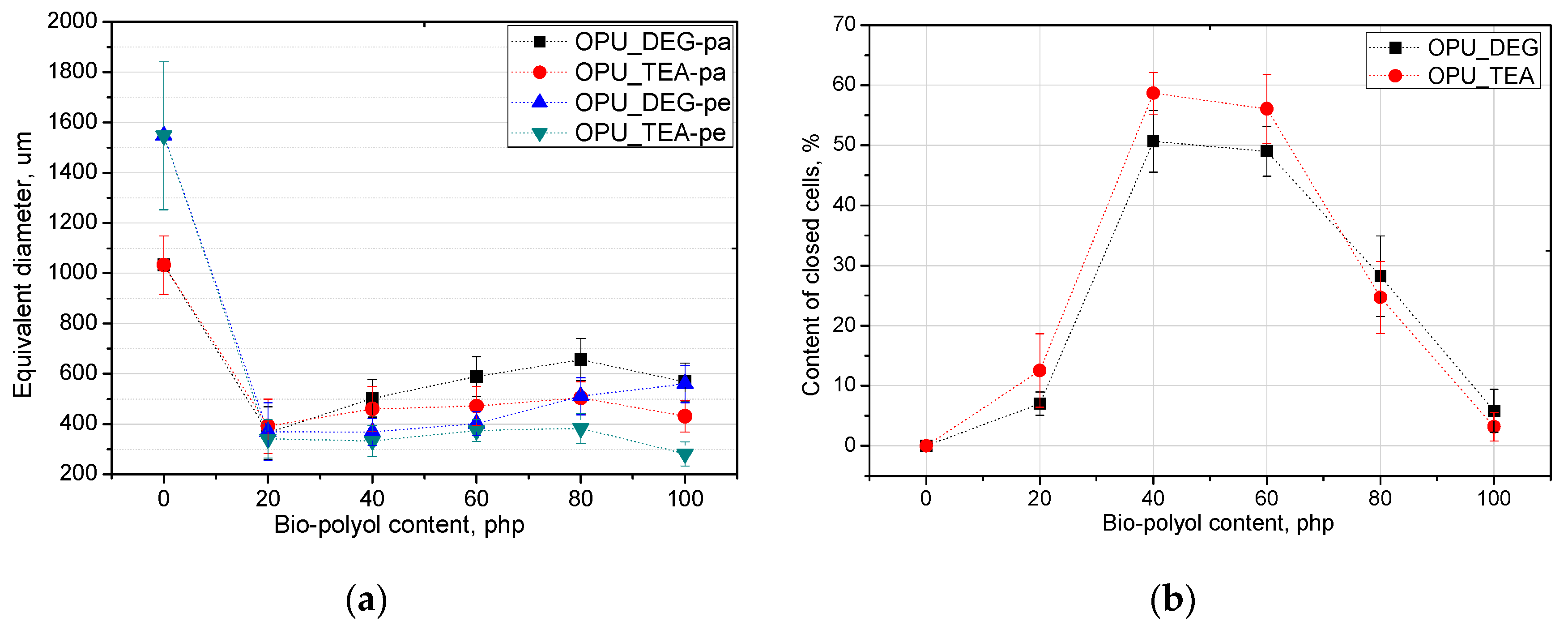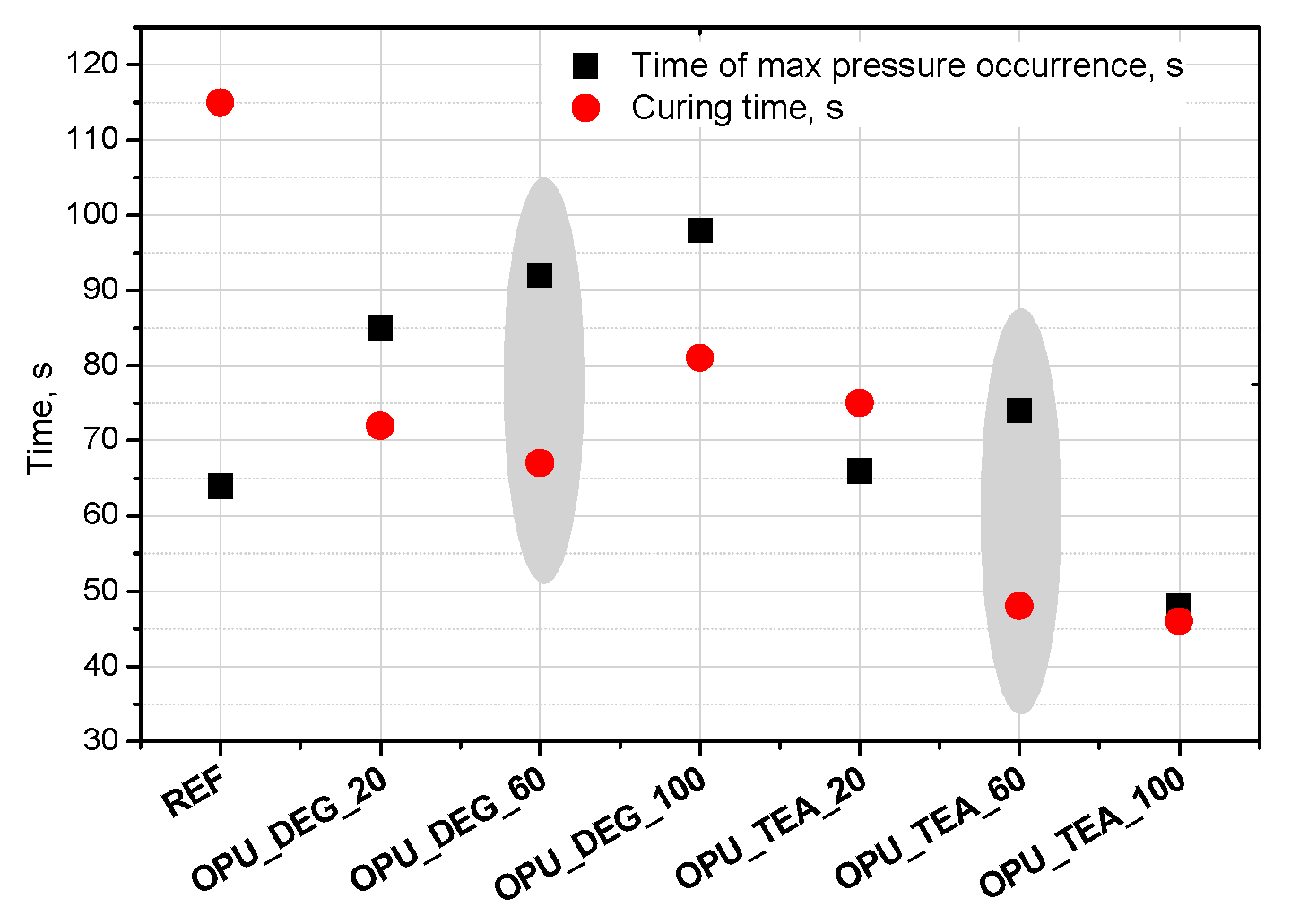A Pathway toward a New Era of Open-Cell Polyurethane Foams—Influence of Bio-Polyols Derived from Used Cooking Oil on Foams Properties
Abstract
1. Introduction
2. Materials and Methods
2.1. Foam Formulation
2.2. Preparation of Samples
2.3. Characterization of Bio-Polyols, Foaming Process and Foam Properties
3. Results and Discussion
4. Conclusions
Author Contributions
Funding
Acknowledgments
Conflicts of Interest
References
- Kurańska, M.; Polaczek, K.; Auguścik-Królikowska, M.; Prociak, A.; Ryszkowska, J. Open-cell polyurethane foams based on modified used cooking oil. Polimery 2020, 216–225. [Google Scholar] [CrossRef]
- Anastas, P.T. Green chemistry and the role of analytical methodology development green chemistry and the role of analytical methodology development. Crit. Rev. Anal. Chem. 2010, 37–41. [Google Scholar] [CrossRef]
- Fridrihsone, A.; Abolins, A.; Kirpluks, M. Screening life cycle assessment of tall oil-based. Energies 2020, 13, 5249. [Google Scholar] [CrossRef]
- Kirpluks, M.; Vanagas, E.; Abolins, A.; Michałowski, S.; Fridrihsone, A.; Cabulis, U. High functionality bio-polyols from tall oil and rigid polyurethane foams formulated solely using bio-polyols. Materials 2020, 13, 1985. [Google Scholar] [CrossRef]
- Kurańska, M.; Barczewski, M.; Uram, K.; Lewandowski, K.; Prociak, A.; Michałowski, S. Basalt waste management in the production of highly effective porous polyurethane composites for thermal insulating applications. Polym. Test. 2019, 76, 90. [Google Scholar] [CrossRef]
- Członka, S.; Sienkiewicz, N.; Strąkowska, A.; Strzelec, K. Keratin feathers as a filler for rigid polyurethane foams on the basis of soybean oil polyol. Polym. Test. 2018, 72, 32–45. [Google Scholar] [CrossRef]
- Członka, S.; Bertino, M.F.; Strzelec, K.; Strąkowska, A.; Masłowski, M. Rigid polyurethane foams reinforced with solid waste generated in leather industry. Polym. Test. 2018, 69, 225. [Google Scholar] [CrossRef]
- Chen, M.; Wang, X.; Tao, M.; Liu, X.; Liu, Z.; Zhang, Y.; Zhao, C.; Wang, J. Full substitution of petroleum-based polyols by phosphorus-containing soy-based polyols for fabricating highly flame-retardant polyisocyanurate foams. Polym. Degrad. Stab. 2018, 154, 312–322. [Google Scholar] [CrossRef]
- Dhaliwal, G.S.; Anandan, S.; Chandrashekhara, K.; Lees, J.; Nam, P. Development and characterization of polyurethane foams with substitution of polyether polyol with soy-based polyol. Eur. Polym. J. 2018, 107, 105–117. [Google Scholar] [CrossRef]
- Kirpluks, M.; Kalnbunde, D.; Walterova, Z.; Cabulis, U. rapeseed oil as feedstock for high functionality polyol synthesis. J. Renew. Mater. 2017, 5, 258–270. [Google Scholar] [CrossRef]
- Kirpluks, M.; Kalnbunde, D.; Benes, H.; Cabulis, U. Natural oil based highly functional polyols as feedstock for rigid polyurethane foam thermal insulation. Ind. Crops Prod. 2018, 122, 627–636. [Google Scholar] [CrossRef]
- Kurańska, M.; Prociak, A. The influence of rapeseed oil-based polyols on the foaming process of rigid polyurethane foams. Ind. Crop. Prod. 2016, 89. [Google Scholar] [CrossRef]
- Marcovich, N.E.; Kurańska, M.; Prociak, A.; Malewska, E.; Bujok, S. The effect of different palm oil-based bio-polyols on foaming process and selected properties of porous polyurethanes. Polym. Int. 2017, 66. [Google Scholar] [CrossRef]
- Suresh, K.I. Rigid polyurethane foams from cardanol: Synthesis, structural characterization, and evaluation of polyol and foam properties. ACS Sustain. Chem. Eng. 2013, 1, 232–242. [Google Scholar] [CrossRef]
- Fu, C.; Liu, J.; Xia, H.; Shen, L. Progress in organic coatings effect of structure on the properties of polyurethanes based on aromatic cardanol-based polyols prepared by thiol-ene coupling. Prog. Org. Coat. 2015, 83, 19–25. [Google Scholar] [CrossRef]
- Kurańska, M.; Leszczyńska, M.; Malewska, E.; Prociak, A.; Ryszkowska, J. Implementation of circular economy principles in the synthesis of polyurethane foams. Polymers 2020, 12, 2068. [Google Scholar] [CrossRef]
- Zhang, G.; Wu, Y.; Chen, W.; Han, D.; Lin, X.; Xu, G. Open-cell rigid polyurethane foams from peanut shell-derived polyols prepared under Different post-processing conditions. Polymers 2019, 11, 1392. [Google Scholar] [CrossRef]
- Prociak, A.; Kurańska, M.; Cabulis, U.; Ryszkowska, J.; Leszczyńska, M.; Uram, K.; Kirpluks, M. Effect of bio-polyols with different chemical structures on foaming of polyurethane systems and foam properties. Ind. Crop. Prod. 2018, 120. [Google Scholar] [CrossRef]
- Kurańska, M.; Pinto, J.A.; Salach, K.; Barreiro, M.F.; Prociak, A. Synthesis of thermal insulating polyurethane foams from lignin and rapeseed based polyols: A comparative study. Ind. Crop. Prod. 2020, 143, 111882. [Google Scholar] [CrossRef]
- Kurańska, M.; Leszczyńska, M.; Kubacka, J.; Prociak, A.; Ryszkowska, J. Effects of modified used cooking oil on structure and properties of closed-cell polyurethane foams. J. Polym. Environ. 2020, 28, 2780–2788. [Google Scholar] [CrossRef]
- Członka, S.; Bertino, M.F.; Strzelec, K. Rigid polyurethane foams reinforced with industrial potato protein. Polym. Test. 2018, 68, 135–145. [Google Scholar] [CrossRef]
- Septevani, A.A.; Evans, D.A.C.; Chaleat, C.; Martin, D.J.; Annamalai, P.K. A systematic study substituting polyether polyol with palm kernel oil based polyester polyol in rigid polyurethane foam. Ind. Crop. Prod. 2015, 66, 16–26. [Google Scholar] [CrossRef]
- Zhang, C.; Kessler, M. Bio-based polyurethane foam made from compatible blends of vegetable-oil-based polyol and petroleum-based polyol. ACS Sustain. Chem. Eng. 2015, 3, 743–749. [Google Scholar] [CrossRef]
- Piszczyk, Ł.; Strankowski, M.; Danowska, M.; Hejna, A.; Haponiuk, J.T. Rigid polyurethane foams from a polyglycerol-based polyol. Eur. Polym. J. 2014, 57, 143–150. [Google Scholar] [CrossRef]
- Zhou, W.; Bo, C.; Jia, P.; Zhou, Y.; Zhang, M. Effects of tung oil-based polyols on the thermal stability, flame retardancy, and mechanical properties of rigid polyurethane foam. Polymers 2018. [Google Scholar] [CrossRef] [PubMed]
- Palanisamy, A.; Karuna, M.S.L.; Satyavani, T.; Kumar, D.B.R. Development and characterization of water-blown polyurethane foams from diethanolamides of karanja oil. J. Am. Oil Chem. Soc. 2011, 88, 541–549. [Google Scholar] [CrossRef]
- Hejna, A.; Kirpluks, M.; Kosmela, P.; Cabulis, U.; Haponiuk, J.; Piszczyk, Ł. The influence of crude glycerol and castor oil-based polyol on the structure and performance of rigid polyurethane-polyisocyanurate foams. Ind. Crop. Prod. 2017, 95, 113–125. [Google Scholar] [CrossRef]
- Kurańska, M.; Polaczek, K.; Auguścik-Królikowska, M.; Prociak, A.; Ryszkowska, J. Open-cell rigid polyurethane bio-foams based on modified used cooking oil. Polymer 2020, 190, 1–7. [Google Scholar] [CrossRef]
- Hawkins, M.C.; Toole, B.O.; Jackovich, D. Cell morphology and mechanical properties of rigid polyurethane foam. J. Cell. Plast. 2005, 41, 267–285. [Google Scholar] [CrossRef]








| Properties | UCO_TEA | UCO_DEG | Rokopol 551 |
|---|---|---|---|
| Hydroxyl value, mgKOH/g | 348 | 277 | 420 |
| Acid value, mgKOH/g | 2.31 | 1.35 | 0.10 |
| Water content, % mas. | 0.05 | 0.13 | 0.10 |
| Average molecular weight, g/mol | 522 | 492 | ~600 |
| Viscosity, mPa·s | 182 | 56 | 3000–5000 |
| Functionality | ~2.2 | ~1.9 | ~4.5 |
| Raw Materials, g | REF | OPU_DEG_20 OPU_TEA_20 | OPU_DEG_40 OPU_TEA_40 | OPU_DEG_60 OPU_TEA_60 | OPU_DEG_80 OPU_TEA_80 | OPU_DEG_100 OPU_TEA_100 |
|---|---|---|---|---|---|---|
| Rokopol 551 | 100 | 80 | 60 | 40 | 20 | 0 |
| Bio-polyol UCO_DEG or UCO_TEA | 0 | 20 | 40 | 60 | 80 | 100 |
| Polycat 218 | 4 | 4 | 4 | 4 | 4 | 4 |
| Tegostab8870 | 4.5 | 4.5 | 4.5 | 4.5 | 4.5 | 4.5 |
| Ortegol 500 | 0.5 | 0.5 | 0.5 | 0.5 | 0.5 | 0.5 |
| Water | 15 | 15 | 15 | 15 | 15 | 15 |
| Ongronat 2100 | 332 | 323.4 | 314.8 | 306.4 | 297.8 | 289.3 |
| 328.1 | 324.2 | 320.3 | 316.4 | 312.4 |
| Symbol | Coefficient of Thermal Conductivity Measured at Average Temperature, mW/m·K: | |||||
|---|---|---|---|---|---|---|
| 0 °C | 10 °C | 20 °C | ||||
| REF | 41.35 | ±0.17 | 43.90 | ±0.16 | 45.83 | ±0.57 |
| OPU_DEG_20 | 36.95 | ±0.16 | 38.95 | ±0.50 | 40.05 | ±0.12 |
| OPU_DEG_40 | 42.38 | ±0.63 | 43.60 | ±4.97 | 44.28 | ±1.52 |
| OPU_DEG_60 | 37.93 | ±0.62 | 39.76 | ±0.23 | 41.62 | ±1.40 |
| OPU_DEG_80 | 38.47 | ±0.32 | 40.16 | ±0.70 | 42.62 | ±0.78 |
| OPU_DEG_100 | 39.15 | ±0.44 | 41.34 | ±0.58 | 43.17 | ±0.44 |
| OPU_TEA_20 | 35.99 | ±1.62 | 37.63 | ±1.90 | 39.98 | ±2.05 |
| OPU_TEA_40 | 36.00 | ±0.46 | 37.96 | ±1.06 | 39.93 | ±0.74 |
| OPU_TEA_60 | 37.25 | ±1.50 | 39.57 | ±0.80 | 41.68 | ±0.72 |
| OPU_TEA_80 | 37.18 | ±0.24 | 39.02 | ±0.43 | 41.61 | ±0.31 |
| OPU_TEA_100 | 37.15 | ±1.41 | 39.06 | ±1.31 | 40.44 | ±1.22 |
| Symbol | Dimensional Stability at 70 °C after 24 h/48 h, % | Dimensional Stability at −25 °C after 24 h/48 h, % | ||||
|---|---|---|---|---|---|---|
| Length | Width | Thickness | Length | Width | Thickness | |
| REF | −0.15/0.12 | −0.46/0.50 | −0.52/0.04 | −0.04/−0.34 | 0.07/−0.15 | 0.07/−0.97 |
| OPU_DEG_20 | 0.22/0.24 | 0.51/0.30 | 0.49/0.46 | 0. 40/−0.01 | 0.07/−0.29 | 0.05/−0.68 |
| OPU_DEG_40 | 0.37/0.33 | 0.33/0.24 | 0.69/0.43 | 0.03/−0.18 | −0.07/−0.16 | −0.20/−0.66 |
| OPU_DEG_60 | 0.39/0.28 | 0.38/0.35 | −0.30/−0.17 | 0.15/−0.04 | −0.08/−0.24 | −0.09/−0.60 |
| OPU_DEG_80 | 0.61/0.56 | 0.45/0.22 | 0.34/0.07 | −0.07/−0.26 | −0.13/−0.22 | −0.76/−1.26 |
| OPU_DEG_100 | −0.10/−0.25 | 0.12/−0.09 | 0.39/0.29 | −0.06/−0.01 | −0.11/−0.22 | −0.40/−0.15 |
| OPU_TEA_20 | −0.48/−0.76 | 0.30/0.19 | 0.49/−0.06 | 0.04/−0.02 | 0.26/0.10 | 0.79/0.86 |
| OPU_TEA_40 | 0.14/−0.06 | 0.12/−0.15 | 0.60/0.01 | 0.09/0.01 | 0.11/0.00 | 0.37/0.04 |
| OPU_TEA_60 | 0.89/0.97 | 0.30/0.16 | 0.90/0.86 | 0.12/−0.01 | 0.13/0.09 | 0.28/0.22 |
| OPU_TEA_80 | 0.16/−0.06 | 0.12/−0.10 | −0.01/−0.42 | −0.11/−0.15 | 0.02/−0.10 | −0.12/0.14 |
| OPU_TEA _100 | 1.46/1.36 | 1.37/1.29 | 1.65/1.47 | −0.19/−0.42 | −0.15/−0.29 | −0.41/−0.42 |
Publisher’s Note: MDPI stays neutral with regard to jurisdictional claims in published maps and institutional affiliations. |
© 2020 by the authors. Licensee MDPI, Basel, Switzerland. This article is an open access article distributed under the terms and conditions of the Creative Commons Attribution (CC BY) license (http://creativecommons.org/licenses/by/4.0/).
Share and Cite
Kurańska, M.; Malewska, E.; Polaczek, K.; Prociak, A.; Kubacka, J. A Pathway toward a New Era of Open-Cell Polyurethane Foams—Influence of Bio-Polyols Derived from Used Cooking Oil on Foams Properties. Materials 2020, 13, 5161. https://doi.org/10.3390/ma13225161
Kurańska M, Malewska E, Polaczek K, Prociak A, Kubacka J. A Pathway toward a New Era of Open-Cell Polyurethane Foams—Influence of Bio-Polyols Derived from Used Cooking Oil on Foams Properties. Materials. 2020; 13(22):5161. https://doi.org/10.3390/ma13225161
Chicago/Turabian StyleKurańska, Maria, Elżbieta Malewska, Krzysztof Polaczek, Aleksander Prociak, and Joanna Kubacka. 2020. "A Pathway toward a New Era of Open-Cell Polyurethane Foams—Influence of Bio-Polyols Derived from Used Cooking Oil on Foams Properties" Materials 13, no. 22: 5161. https://doi.org/10.3390/ma13225161
APA StyleKurańska, M., Malewska, E., Polaczek, K., Prociak, A., & Kubacka, J. (2020). A Pathway toward a New Era of Open-Cell Polyurethane Foams—Influence of Bio-Polyols Derived from Used Cooking Oil on Foams Properties. Materials, 13(22), 5161. https://doi.org/10.3390/ma13225161





